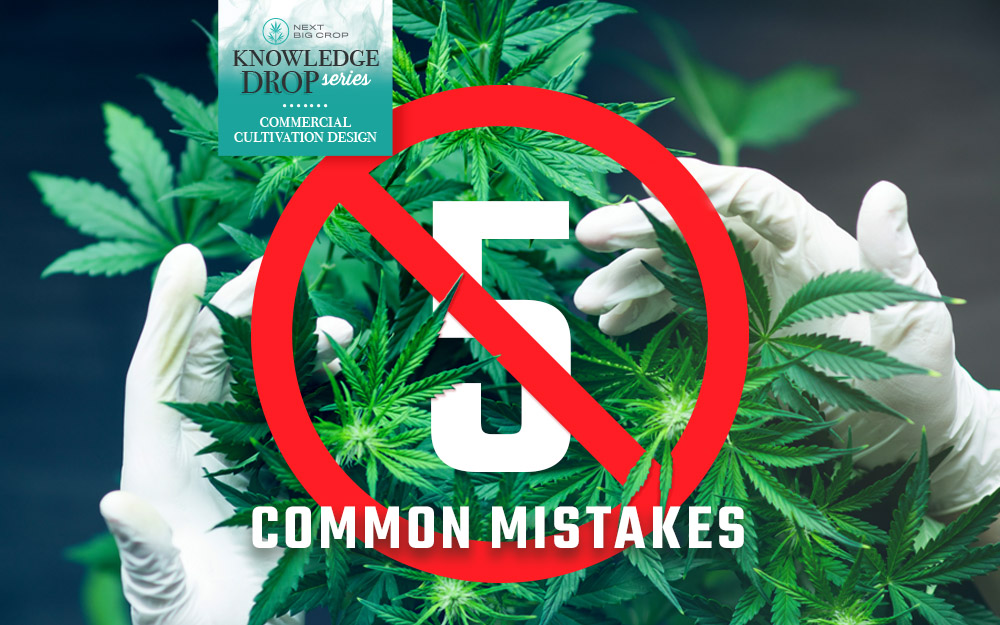By Aaron Mullins, Systems Coordinator at Next Big Crop
Designing a facility to grow, harvest and prepare cannabis for manufacturing or retail is a complex enterprise that interweaves environmental, infrastructure and regulatory compliance concerns. It’s a lot easier to get wrong than right, and some errors can cost millions of dollars. Here are the five biggest cannabis cultivation facility design mistakes we see today.
Mistake #1: Overlooking the Underlying Costs of Your Location
When it comes to selecting a site to set up your cannabis cultivation facility, it’s easy to be seduced by the low cost per square foot one finds in a less-developed area. However, the temptation to save money up front can lead to a slew of costs that quickly eat up the initial savings. Water quality, availability of utilities, and local regulations often lead to additional costs and delays. For instance, we have seen facilities that are at the mercy of their local utility providers, waiting upwards of two years for power lines to reach them.
There are no hard-and-fast rules when it comes to choosing a location, but each site will have particular advantages and disadvantages, and it’s important to be able to assess them in detail before investing.
Mistake #2: Cutting Back on HVAC
Many facility decision-makers seriously underestimate how much cooling they need. We’ve seen people setting up with less than a tenth of what their operation required. Unless you are trying to fry all of your plants (or operate under capacity), you need an HVAC system that can handle your cultivation needs no matter the season.
A good rule of thumb is one ton of cooling for every two HPS lights or four LED lights. Many cultivators are similarly unconcerned about humidity control. Invest in HVAC—and associated humidity mitigation—or watch your profits burn up.
Mistake #3: Inefficient Cultivation Facility Design
An employee is moving a set of plants from a flower room to a processing room. How far do they have to travel? What other parts of the facility do they have to pass through? If one of those plants has mold on it, where might that mold spread to?
Cultivation facility design is about more than fitting the puzzle pieces of your facility into the space you have to work with, it’s about creating workflows that maximize efficiencies and minimize contamination.
Mistake #4: Forgetting About Your Real Money Makers: Your Employees
You can have the best cultivation facility design in the world, and it won’t matter if your employees are under-skilled, under-resourced or underpaid. Depending on their role and any biological sensitivities, your team may need chemical-resistant coverall suits, masks, eye shields and other personal protective equipment.
It’s worth noting that the cannabis industry falls under the jurisdiction of the Occupational Safety and Health Administration (OSHA), and cultivation facilities are required to comply with OSHA standards for the health and safety of their workers. Failure to do so can result in steep fines.
Invest in your workers’ skills and experience when you hire, and then invest in their health, safety, comfort and ease of operating. Your plants are important, but they are secondary to the people you employ.
Mistake #5: Not Being Serious About Security
If your facility is producing millions of dollars’ worth of product, but your vault manager is making barely above minimum wage, don’t be surprised if inventory or cash goes missing. It is imperative to make theft as difficult as possible, and to disincentivize attempts before they happen. We recommend a vault made of reinforced concrete, not attached to an exterior wall, with access limited to trusted, well-compensated employees. Security can be expensive, but it beats watching your profits walk out the door.
It’s always tempting to cut corners in cannabis cultivation facility design, but whatever savings you gain in buildout will vanish within a year or two. The best way to fix these mistakes is to never make them in the first place.
Not sure where to start or need help procuring resources? Email us at info@nextbigcrop.com for a free consultation.
